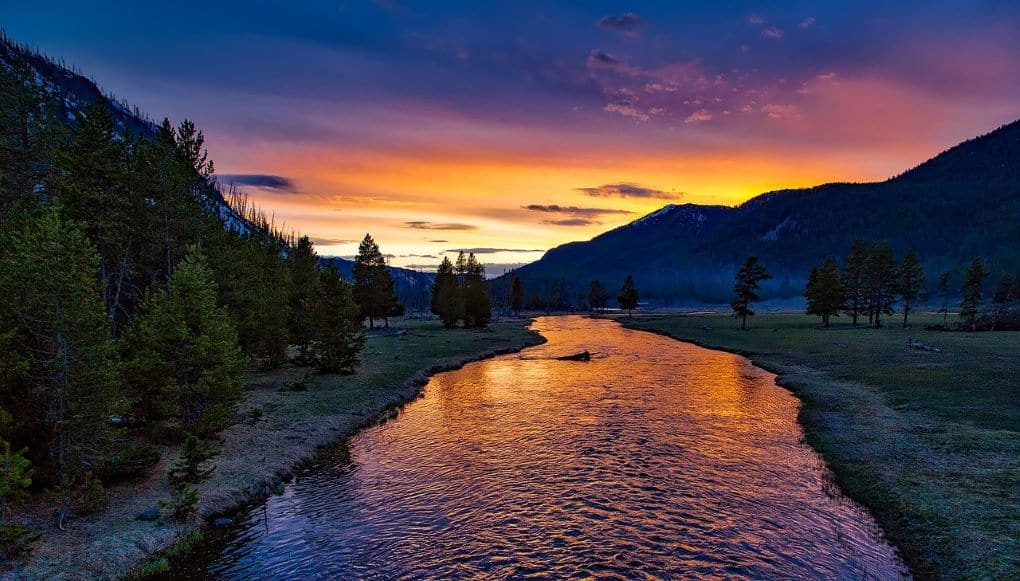Grand Canyon has always been at the top of our bucket list. Visiting the Grand Canyon National Park South Rim is an easy 30-minute drive from Cameron, Arizona. Many of the magnificent viewpoints make you feel you are teetering on the edge. For us this is our the last national park stop on our Grand Circle Tour. We had high hopes that it would be just as distinctive as Zion and Bryce National Parks.

This post may contain affiliate links, meaning if you purchase something through one of these links, we may earn a small commission at no extra cost to you! Read the full disclosure policy here.
Table of Contents
Things to Do South Rim Grand Canyon National Park – Starting from Historic Cameron Hotel
This is a legendary Cameron trading post dating back to the early 1900s. We stayed 1 night on the way from Monument Valley to Grand Canyon National Park South Rim. The staff was courteous and friendly. Our room was at the back of the hotel, clean and quiet, with a view of the little Colorado gorge. The hotel is older and the A/C fan rattled a bit. We got a good night’s sleep. We had a nice dinner at the restaurant. Their specialty is the Navajo taco. Be warned, the Navajo Taco is a lot of food for just one person to eat! We would recommend splitting it between two people (the restaurant will cut it in half). The gift shop here is enormous with lots of Native American arts, however this is a popular touristy stop for buses so chances are that they will crowd it.
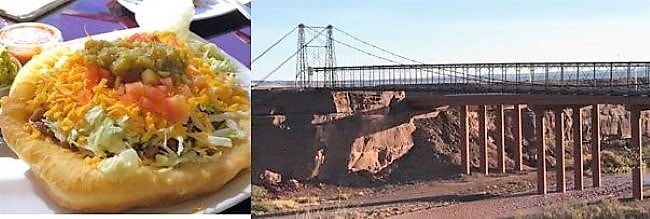
Today we wake early skipping breakfast, since the restaurant does not open before 6 am. Instead, we headed to the East Entrance of Grand Canyon National Park South Rim. The drive is just over an hour along scenic Hwy 64. We had the road to ourselves as we drove toward Desert View. The sunrise was spectacular. Just before we entering the park, we watch a coyote run across the highway in front of us. He grabs a dead rabbit from the middle of the road. He ate the carcass at the side of the road. I videoed the coyote eating the rabbit. It was so exciting.

Know Before You Go: Grand Canyon National Park South Rim
- Entrance Fees & Passes: $35 per vehicle (valid for 7 days). Purchase passes online in advance via Recreation.gov. If you plan to do the grand circle tour, be sure to purchase the America the Beautiful pass. Since this was our 5th National Park, it has paid for itself, covering the $80 cost. When we entered the park, the entrance; gate was not maned due to arriving so early. We already had a park pass, so it was a moot point. I suggest buying an Annual Park pass if you do the grand circle tour. It is more cost effect.
- Operating Hours: The South Rim is open year-round, 24/7. Visitor centers and shuttle routes operate seasonally.
- Parking & Shuttles: Arrive early for parking near major viewpoints like Mather Point. Free shuttle buses operate March–November and are highly recommended. Some areas are shuttle-only during peak season (Hermit Road).
- Pets: Leashed pets allowed on rim trails only, not on inner canyon trails. Kennels available at the South Rim.
- Maps & Visitor Info: Pick up free park maps at entrance stations or Visitor Center. Use the NPS Grand Canyon App for offline maps and alerts.
- What to Bring: Wear sturdy walking or hiking shoes as the trail is loose dirt in some places. A quality trekking stick would be advisable on the switchbacks. Second, take a lot of water and some snack food. Be sure to have a refillable water bottle to quench your thirst in the heat. In the summer, the hot dry air can take its toll if you don’t hydrate.
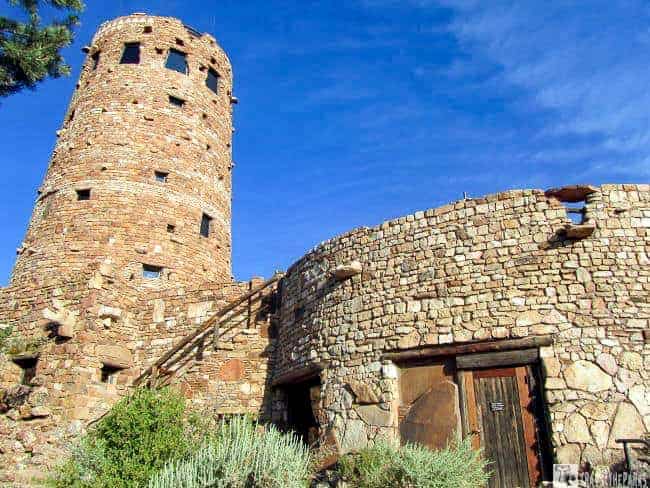
What Are the Must-see Stops on Desert View Drive in Grand Canyon National Park?
The first stop along the 25-mile Desert View Drive was the Desert Viewpoint and Desert Watchtower (7438 feet). We parked in the large parking area. In the early morning light, we wandered towards the canyon edge. They plant the pathways with native vegetation. We smile, watching the ground squirrels nibbling on the seeds of the sagebrush. The views into the canyon are spectacular as we reach the canyon’s edge. With few travelers this early in the morning, we have the tower all to ourselves for the moment. Everything, including the tower, is still closed, so we did not get to see the inside. While we can find vantage points throughout Grand Canyon National Park and the surrounding countryside, nowhere does form meet function so effortlessly or as beautiful as at Desert View Watchtower.

Mary Colter designed the tower in 1932 for the National Park Service. The Santa Fe railway commissioned this replica of a Puebloan watchtower. Although this structure is much larger, brick conceals a steel frame inside. The tower stands 70 ft. tall on the edge of the canyon.

Looking in the windows, we could see the bottom floor of the tower has a gift shop, while the upper floors serve as an observation deck from which visitors get a 360 magnificent panoramic view of the canyon. You can see the Colorado River making a big bend to the west. Look to the east, you can see the Painted Desert and to the south the San Francisco Peaks.

Grand Canyon National Park South Rim Historic Tusayan Ruin and Museum
Desert view drive follows the canyon rim. At this early hour, there is little traffic. Luckily, stopping at all the viewpoints along the canyon road was equally quiet today. A mere shadow of the crowds that we would experience at the more popular points closer to the South Rim Visitor Center and Canyon Village. Our next stop was the Tusayan Ruin. This is the remains of a small ancestral Puebloan village. The museum was closed (opened at 8 am)

The site itself is not huge, the nature trail is a peaceful walk through the 800-year-old Pueblo ruins. They post information on interpretive signs at various places along the path describing the building structures. The site includes a large kiva, several stone houses, a small kiva and a food storage building. Visitors can really get a feeling for how the Tusayan lived on this plateau at the edge of the canyon so many centuries ago. If you are interested in archaeology, it is worth spending some time looking at the exhibits and reading about the people who built the complex and the site itself. There are restrooms and picnic tables in the shade. If you collect the national parks service passport stamps, this is the location for one of the many specific to the park.
Simply Beautiful Grandview Point
The parking lot is easy to access, and they have paved walkways. Easily accessible for all ages and abilities. A short distance down the path is Grandview Point (7400ft). The point juts out into the canyon, providing sweeping views. Here morning and sunrise are especially beautiful. Heavily forested tall pine trees obstruct the views in some places. Honestly, there are no unpleasant views along the South Rim points. I was so excited to see my first Abert’s Squirrel (Sciurus aberti) under a picnic table. They have little tufts on the ears, very cute!

Read the interesting historical information on the interpretive signs. It details how at the beginning of the century, miners arrived looking for gold, silver, and copper. One of these miners. Pete Berry built a hotel here in 1895. Thus bringing the first tourists to what is now Grand Canyon National Park. If you have time, it would be worth the hike to the remnants of the Last Chance copper mine on Horseshoe Mesa. The trail leading into the canyon gets really steep in about 1/4 mile. Be extremely careful.
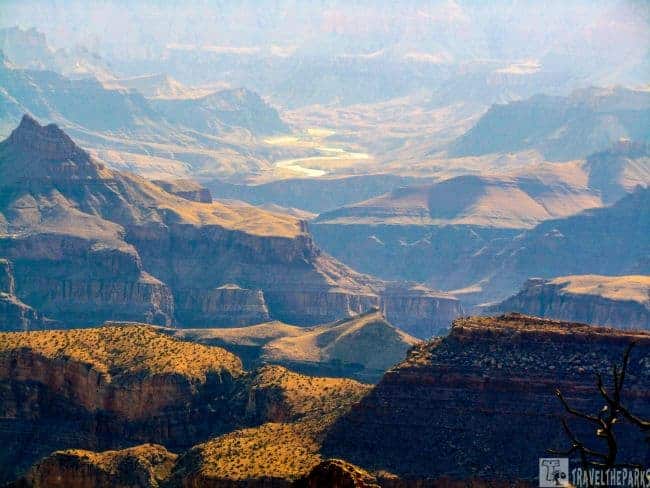
Where are the Best Locations for sunrise or sunset?
There are a few great locations along the south rim to watch the sunrise or sunset. Mather Point, Yavapai Point and Yaki Point are all good for sunrise. For sunset we preferred Pima Point, Mohave Point or Hopi Point.

Take in Sunrise at Yaki Point
You cannot drive to this one. Instead, use the free Kaibab Rim shuttle, also referred to as the Orange route. The views are far-reaching, words just don’t do justice to the beautiful views here. It’s a great place to watch the sunrise. The trailhead for South Kaibab is located nearby Yaki Point, where you can hike down to the Ooh Aah Point.

Best Hike for Sunrise-Ooh Ahh Point
This well-maintained trail is one of the most breathtaking trails we have ever done! The round-trip distance from South Kaibab Trail head to Ooh Aah Point is 1.8 miles. There are restrooms at the start of the trailhead. It took about 25 minutes; we arrived in time to see the sunrise. The trail down is relatively easy with plenty of morning shade on the many switchbacks. This is a popular trail, so you will encounter lots of hikers.
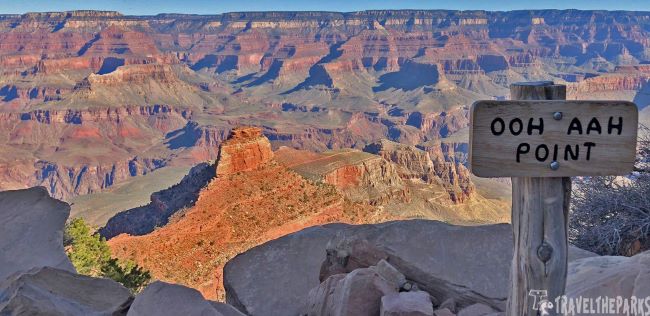
However, coming back up is another story… For us, the struggle was real. Stopping to take pictures on the way back up will help you catch your breath. Although going back up will give the heart and lungs a workout but it is so worth it. Getting below the rim, you gain a tremendous appreciation for the size and grandeur of this magical place. The colors of the canyon walls change with the shifting sun.
This stretch of road from Yaki to the visitor center is the place to see lots of elk. We saw a huge male elk munching on a roadside bush. I could get an outstanding video. The next stop is the South rim park and Canyon Village.
Advice: Bring plenty of water and be prepared to take your time and rest often on your way back up!!! Wearing shoes with good traction and hiking poles can be a good idea. There are rocks and loose gravel, so watch your step- it’s a long way down if you trip or fall.

Grand Canyon National Park South Rim – Stay at Bright Angel Lodge
Tonight we have a reservation at Bright Angel Lodge. We have a rustic rim cabin for one night booked a year in advance. The Bright Angel Lodge origins began as a single cabin and several tents in 1896. Built in 1935, Mary Jane Colter again designed the central unit. They limit parking. I had read reviews that stated drive around till someone leaves, then don’t drive your car till you absolutely have to. Although we did not have a view of the canyon, we were close enough to walk just steps to the canyon rim. The cabin is also convenient to the trailhead, the park shuttle bus system, an ice cream store and many other rim amenities. Despite being so close to the Rim Trail, we never felt our privacy compromised and did not hear any outside noise.

Overnight at The Bright Angel Cabin
The cabin is quite small but spotless, with a fan, a large bed, a small full bathroom. The only negative was that there was no Wi-Fi, and no cell signal in the cabin.
The staff at Bright Angel were very professional, and we actually got checked in early. There wasn’t any air conditioning in the cabins, but the big ceiling fan kept us cool at night. Keeping the curtains closed during the day, then opening the windows in late evening and turning the fan on high helped to keep the cabin cooler inside. In the evenings, the desert air cools nicely near the canyon. The park service personnel from the park shuttle drivers to the waitstaff are very hospitable.
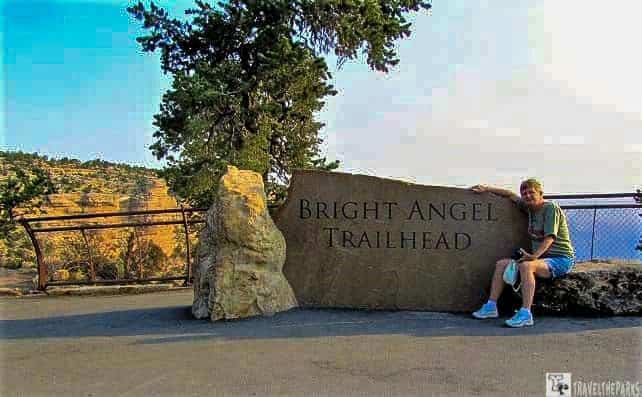
I think for me the bonus of staying in a rim side cabin was following the elk herd in the morning for brilliant pictures. Being awakened by the bugling of elk was better than an alarm clock.
Hike Down the Bright Angel Trail
The Trailhead is located just 100 feet from the rim cabins. It was later in the afternoon when we did the trail. We only walked down as far as the Indian Garden before turning back. The mule train travels this same trail to Phantom Ranch, and it is quite wide. Watch for the mule patties they are everywhere. A novice hiker could make it to the 1.5 or 3.0 mile mark and backup with ease. At the 3-mile mark, Plateau Point affords full views of the river and a panoramic view of the canyon.

Three important facts come to mind if you plan to do this trial. First, make sure you are physically fit. The switch backs help, but the elevation can take its toll. Watch the weather and temperature make all the difference to the enjoyment of this hike. Today the temps are nearing 107 degrees. I would like to return and do the hike to Phantom Ranch the next time we visit.

Look for California Condors
Another plus is that the endangered California Condors like to perch on the cliffs in this area. Luckily, we spot several on the cliff side tonight. We were fortunate to get some great photos of California Condors.
If you have time to take a quick walk to the mule barn and the nearby livery stable were two of the most important building in the original Grand Canyon Village. In the early 1900s, when all travel within the village was by horse-drawn carriage, these enormous barns were the center of all activity. They line the mules up along the fence and you can pet them. It would be nice to experience the mule ride into the canyon, maybe next time.

What are the Best Viewpoint on the Hermits Rest Road Grand Canyon National Park
In the afternoon, we did the Hermit Road. This is only accessible by shuttle bus during the summer months. The park posts rail information at each viewpoint in case you want to walk to the next stop. Buses run every 12 – 15 minutes. It gives people the ability to get on or off at various stops. Buses run frequently. We decided we would take the bus to Powell Point and walk the rim trail out towards Hermits Rest. The canyon changes with every view, so make sure you stop to enjoy them all!

Popular Powell Point
We got off the shuttle at Powell Point. The park service has erected a granite memorial to commemorate John Wesley Powell (1920), honoring his two groundbreaking explorations of the Colorado River. Powell was the first Explorer to raft the river through the canyon. What an amazing feat that was on uncharted waters. Imagine the danger. I wonder how they felt finding this place and hitting those rapids in places. The point allows you to see extended vistas of the canyon to the east. However, because of Hopi Point, the western vistas are somewhat truncated. The Colorado River is again prominent below.

A Must for Sunset see Hopi Point
Early Euro-American entrepreneurs at the Grand Canyon were always on the lookout for the most scenic spots along the rim; places suitable to establish camps where tourists might spend days or weeks. One of these spots along the South Rim was Hopi Point, about two miles west of today’s Grand Canyon Village. Take your break here, as this is the halfway point on the trail. From here you can see the Colorado River as it snakes through the canyon. If you are lucky, you can see the rafters also in the river. I got some great panoramic shots and some great shots overlooking ledges into the Canyon. We did not hike past this point because of the high temperatures we settled for riding the shuttle bus to the other viewpoint, including the end of the road-Hermits Rest.
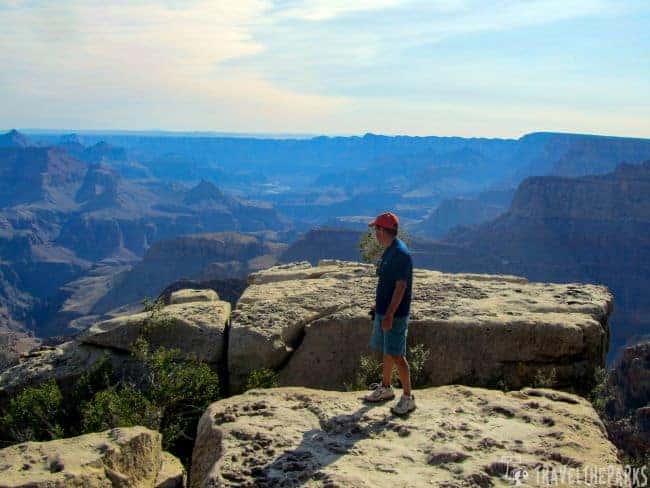
View the Colorado River from Mohave Point
Another impressive view point on our rim hike, even more outstanding as this was after walking around. You are right on the edge of the canyon, in places it is just feet away. From here, visitors can see the Colorado River and the Hermit Rapids below. The Mohave Point is like a long corridor and allows you to see the Canyon on both sides of the peninsula. Making it a great place to take photos. This stop is far enough west that the crowds are somewhat smaller. Directly below you can see the Alligator, a distinctive red sandstone mesa with jagged edges. You can also see the 3,000 foot high cliffs of the neighboring Abyss from the next viewpoint on the trail. There are also no guardrails…be careful, we saw many people taking risky chances to get the perfect selfie.
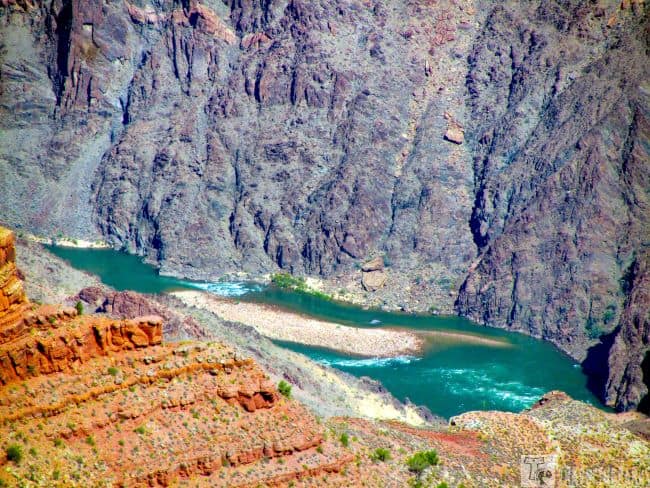
Pima Point Viewpoint Listen to the River
One of the best places along the South Rim to see and (on a quiet day) hear the Colorado River, where water crashes over Granite Rapids below echoes up the canyon walls. There are expansive views in all directions. Mt. Trumbull is visible in the distance. From here are excellent views of the Powell Plateau, and Bright Angel Canyon to the east. On the western side, you can view Hermit Creek and some ruins of the old Hermit’s Camp, and on the north side Ninety-four Mile Creek. While we sat on the edge of the canyon, we saw someone giving water to a squirrel; I do not understand the need to interfere with the wildlife. The squirrels can become aggressive.

End of the Road – Hermit’s Rest View Point
This is the last shuttle stop at the western edge of the developed portion of the Grand Canyon National Park. The first thing you notice is a small stone structure- Hermit’s Rest, nestled back into a mound of earth opening into the canyon. At first glance, it might appear to be a structure hastily erected by an early Euro-American settler in the canyon. However, it is really a carefully constructed building commissioned by the Fred Harvey Company in 1914. The building itself is unique, timber frame and great stone, because the architecture is very different, it blends well with nature and the native history of the area. The immense fireplace is worth checking out inside the gift store. To top it off, there was ice cream, very refreshing in the blistering sun.
The shop also has a small, reasonably priced selection of snacks. There is also a small gift shop that sells the usual stuff, plus some sweatshirts, blankets, and umbrellas. The toilets are permanent porta-potty and there is a water station to refill your water bottles.

Have Dinner at the El Tovar Lodge Dining Room
Coming all this way to the Grand Canyon National Park, South Rim requires going all out. For instance, we went all out for our last day of vacation and made reservations at the El Tovar Lodge Dining Room.
We had looked at the menu prior to our stay, because we knew exactly what we wanted so we could order quickly. I had the sautéed duck breast with blueberry compote, roasted red potato, and carrots. Perfectly cooked served beautifully on the plate. Barry had the veal jägerschnitzel, also nicely done, and he loved the German potatoes. The Crème Brule we shared for dessert. The service was quick and very professional. We had the most amazing views of the canyon through the windows, are an added extra. The lodge emits an amazing atmosphere. This is an expensive dinner, but the memory will last us a lifetime. Would eat here again, highly recommend spending extra for this fine dining experience.

Walk the El Tovar -Grand Canyon National Park South Rim
The El Tovar Hotel sits on a dizzying perch just 20 feet from the edge of the Grand Canyon. It is the premier lodging facility in the park, opening in 1905. Constructed from large timbers and rubble masonry, the Hotel was designed to harmonize with its surroundings. Locally sourced stone helps it blend seamlessly into the canyon landscape, while massive Douglas fir logs—brought in by rail from Oregon—add rustic character. Over the years, the Hotel has welcomed notable guests including Theodore Roosevelt, Albert Einstein, famed Western author Zane Grey, and many others. We walked through the lodge area after dinner. The common spaces were welcoming, and the history was shining through. The back porch has rocking chairs. These fill early with people enjoying a drink from the bar, taking in the canyon’s view, waiting for sunset.

Renown Mather Point for Sunrise
An iconic viewpoint, Mather Point is the closest to the Grand Canyon National Park South Rim Visitor Center. A really marvelous view but gets very crowded. Most tour buses stop here, and it is the first viewpoint for most visitors when they enter the park. The crowds can be a bit intimidating with the sheer number of selfie seekers. There is an expansive view, so go, but temper your expectations for a quiet experience. Walk a bit either way on the rim trail to get away from the crowds and have a better sense of this place. The paved pathways on either side also provide a great vantage point, with places to sit just taking in the canyon views. A phenomenal place to watch the sunrise or sunset. The canyon walls come alive with color as the shadows fade.
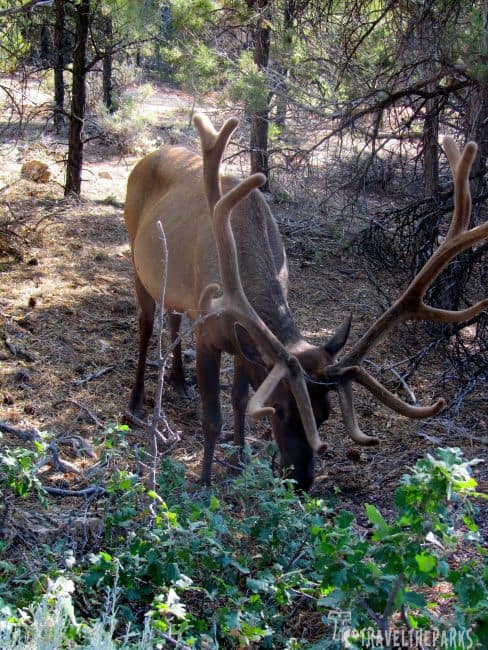
Get an Education at Yavapai Observation Station
They built the station in 1928. If you want to know about the geology of the Grand Canyon, this is the place to visit. There is an excellent view of the inner canyon and Mather Point too. The center of the room is a large topographic relief model that mimics the canyon view in remarkable detail. Could not resist putting together a video on weathering & erosion of the Grand Canyon for my classroom.
The Grand Canyon became a national park in 1919 by President Woodrow Wilson. The Park is 277 miles long, up to 18 miles wide, and attains a depth of over a mile. 5 million people visit the Grand Canyon every year.

The Colorado River has carved the Grand Canyon over several million years. The river’s cutting power was greatly increased by the geologic uplift of the Colorado Plateau, which is a raised area of mountains and plateaus around the Four Corners area. This tectonic movement caused the Colorado River to carve out an alternative route to the west coast.
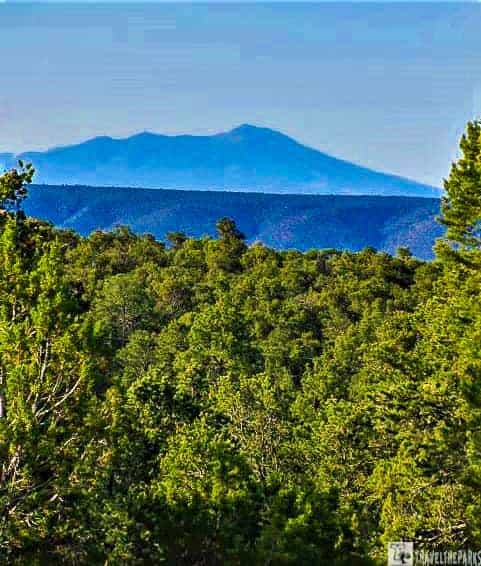
Follow the “Trail of Time”
Over time, erosion, weathering, and climate played a major role in carving the canyon we see today. It has carved the canyon through sedimentary layers of sandstone, limestone, and shale. The carving continues into the basement formations of mostly metamorphic schists and igneous granite. The Grand Canyon is a testimony to the erosive power of water. At the bottom of the Canyon you’ll find the region’s oldest exposed rocks: Vishnu Schist and Zoroaster Granite. There are 12 distinctive multi-colored layers of rock that provide a timeline of the rock formation. Inside the Geology museum, you get to see a much more detailed geological timeline. Be sure to have kids walk the “Trail of Time” to learn more.
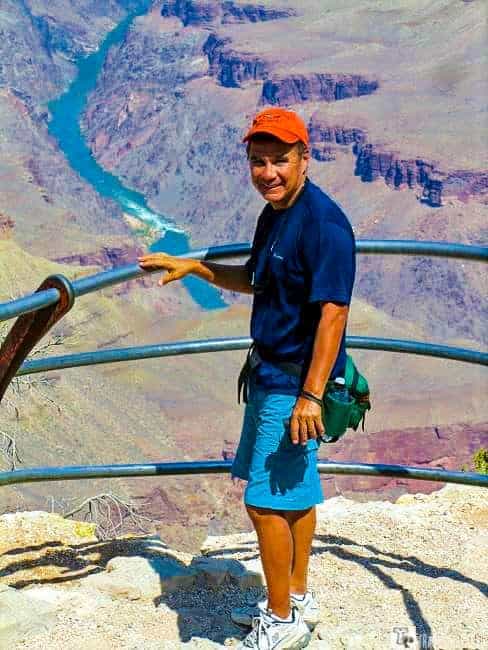
Final Thoughts-Grand Canyon National Park South Rim -Teetering the Edge
The Grand Canyon south rim is the most visited, however I found the north rim to be just as beautiful yet far less crowded. Although Barry preferred the south rim, the solitude was better on the north side. We would like to come back during the winter months to see the contrast of the different seasons.
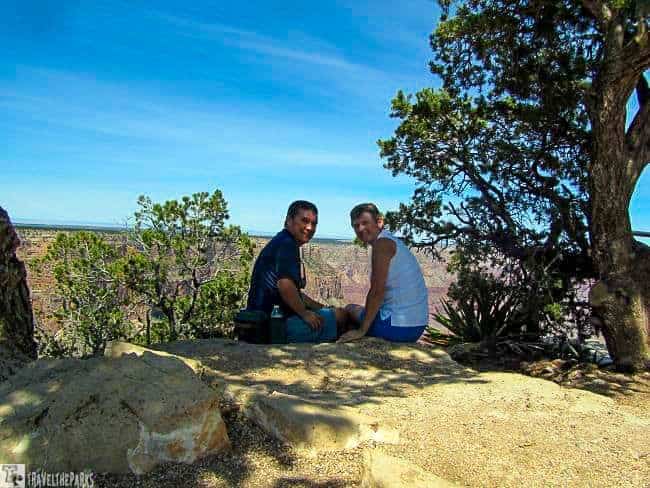
If you have the chance to spend more than a few days at the canyon, the trip into the canyon via the Kaibab or bright angel trail would be worth exploring. The Grand Canyon needs to be on everyone’s bucket list!
Have you been to the Grand Canyon South Rim? What was your favorite memory? We would love to have you share. Please share your memories with us in the comments below.




